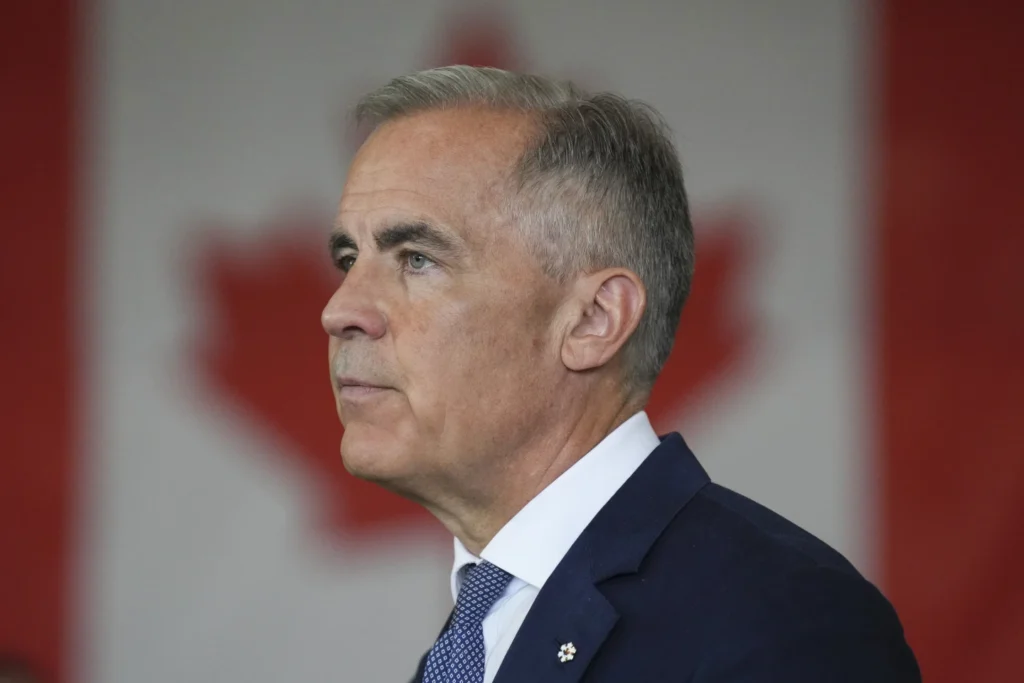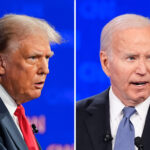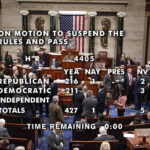Trump Imposes 35% Tariffs on Canadian Goods/ Newslooks/ WASHINGTON/ J. Mansour/ Morning Edition/ President Donald Trump raised tariffs on Canadian imports to 35%, accusing Canada of insufficient action on drug trafficking. The move follows a breakdown in trade talks and criticism of Canada’s decision to recognize a Palestinian state. Prime Minister Mark Carney vowed to protect Canadian industries and diversify exports.

U.S.-Canada Tariff Clash: Quick Looks
- Tariffs on Canadian goods raised from 25% to 35%, effective immediately
- Trump cites lack of Canadian enforcement against drug trafficking as justification
- Palestinian state recognition by Canada worsens trade tensions
- Canadian Prime Minister Mark Carney expresses disappointment and promises export diversification
- Lumber, steel, aluminum, and auto sectors among the hardest hit
- Some Canadian goods still protected under the USMCA, up for renegotiation in 2026
- Additional 40% tariffs on transshipped goods not covered by USMCA
- Canada supplies just 1% of U.S. fentanyl, according to Ottawa
- White House statement blames Canada for failing to meet “security cooperation” standards
- Mexico secures 90-day tariff reprieve, highlighting contrast in regional trade relations
Deep Look: Trump Escalates Trade War with Canada, Cites Drug Concerns and Diplomatic Rift
WASHINGTON — In a sweeping escalation of his ongoing trade war, President Donald Trump on Thursday ordered a 35% tariff on Canadian imports, up from the previous 25%, blaming Canada for inadequate cooperation on combatting illicit drug trafficking, particularly fentanyl. The tariff hike took effect Friday, according to a late-night White House announcement.
The decision injects fresh tension into one of the United States’ oldest alliances, and comes just weeks after Trump threatened to penalize Ottawa unless a new bilateral trade deal was struck by August 1.
“Canada has failed to do more to arrest, seize, detain or otherwise intercept traffickers, criminals at large, and illicit drugs,” the White House statement read.
Canada’s Recognition of Palestine Adds Fuel
Earlier in the day, Trump expressed frustration with Canada’s move to recognize a Palestinian state, saying it would “make it very hard” to reach any trade accord. The timing of the recognition — just ahead of the U.N. General Assembly — added diplomatic weight to a decision that Trump clearly interpreted as a provocation.
The Canadian government, under Prime Minister Mark Carney, responded by expressing deep disappointment. Carney emphasized that Canada has already invested heavily in border security, and pointed out that the nation is responsible for only 1% of U.S. fentanyl imports.
“Ottawa will not sign any trade deal unless it serves Canadians’ best interests,” Carney said. “We’ll continue working to diversify our export markets and reduce dependency on U.S. trade.”
Industries Bracing for Impact
The tariffs are expected to hit major Canadian sectors including lumber, steel, aluminum, and automobiles. Carney noted these industries will face serious exposure to the new duties, and promised government support to cushion the blow.
Trump’s order also introduced a new 40% tariff on goods transshipped through Canada that fall outside the 2020 United States-Mexico-Canada Agreement (USMCA). While the USMCA still shields some products from new levies, the trade pact itself is slated for renegotiation in 2026 — adding another layer of uncertainty for cross-border commerce.
“This is the most aggressive move against Canada’s economy since the steel and aluminum tariffs in 2018,” said a former U.S. trade negotiator.
Trump’s Trade Tactic and Regional Contrast
Trump has increasingly framed trade policy through the lens of national security and domestic manufacturing. Earlier this year, he floated the idea of Canada becoming the 51st U.S. state — comments dismissed by Ottawa but indicative of Trump’s assertive posture.
The president’s stance on Canada contrasts with his 90-day tariff freeze for Mexico, which he announced after a phone call with Mexican President Claudia Sheinbaum. Mexico’s 25% tariffs will remain in place during the negotiating window, allowing time for new terms.
Meanwhile, Canada was excluded from Trump’s updated global tariff schedule, which covers 66 countries, including Taiwan and the European Union. Those import duties are set to begin August 7.
Diplomatic Fallout and Legal Ambiguity
Canada’s recognition of Palestine placed it among a growing list of Western countries supporting a two-state solution — a diplomatic position Trump has increasingly resisted. By linking Canada’s foreign policy to trade punishment, critics argue Trump is blurring lines between international diplomacy and economic coercion.
There is also legal ambiguity surrounding Trump’s authority to act unilaterally. Similar tariff orders have faced judicial scrutiny, with federal courts questioning the executive branch’s expansive interpretation of emergency powers under the Trade Expansion Act of 1974.
What Comes Next?
With U.S.-Canada relations now straining under the weight of tariffs, fentanyl accusations, and geopolitical divergence, many fear that the once-stable partnership could erode further. The Canadian government has hinted it may retaliate with its own trade barriers if talks collapse entirely.
Meanwhile, the Canadian public and business community are already feeling the effects. Prices on imported U.S. consumer goods have begun to climb, and Canadian exporters are scrambling to secure alternative markets in Europe and Asia.
The Trump administration, however, insists the pressure will yield results.
“We are prioritizing American security and manufacturing. These tariffs are part of a strategy to rebalance trade and restore fairness,” a White House spokesperson said.
But with fentanyl, Palestine, and trade deficits all entwined, the path ahead promises further confrontation — and few easy resolutions.







